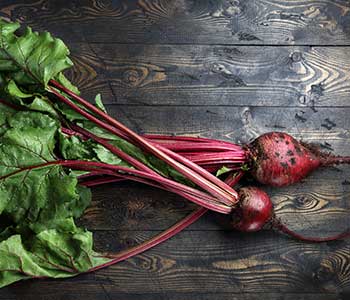
Stalk, leaf & tuber: beetroot total
Beetroot leads a double life in Austria: long since a star ingredient in haute cuisine, it remains a rare guest in many bistro kitchens and private households. Yet it has everything it takes to end up on our plates more often. And not just as a salad!
June 2025
I am from a 'vinegar-loving family': pickled gherkins, pearl onions, mustard pickles, 'Russian herrings', peppers stuffed with sauerkraut - a real treat! No sooner is the jar in the fridge than it's empty again. The same goes for beetroot salad, preferably with freshly grated horseradish. Always a hit! Always delicious.
Salad is just the usual way beetroot is eaten in Austria. But it can be so much more! There are many versatile recipes, and it can be enjoyed raw, cooked, baked or fermented. Its sweet, earthy aroma combines wonderfully with other ingredients.
Pickled beetroot stems
- 300-400 g fresh stems (approx. 0.5 cm in diameter)
- 250 ml water
- 150 ml white wine vinegar or apple cider vinegar (5% acidity)
- 1 tablespoon sugar
- 1-2 teaspoons salt
If you like, you can also add garlic, peppercorns, bay leaves and mustard seeds.
- Wash the stems thoroughly and cut them into 10 cm long pieces, place them tightly in a sterilised screw-top jar.
- Bring the water, vinegar, sugar, salt (and spices) to the boil and simmer briefly, then pour over the stems to the brim. Everything should be well covered. Close the lid tightly immediately.
- Turn the jars upside down and leave to cool (for a vacuum effect). Then store in a cool, dark place.
A simple plant. Beetroot is easy to grow, loves sunshine, loose soil and a little care when watering. It is harvested from late spring to autumn. It can be stored throughout the winter. Then it tastes divine when baked in the oven!
Super healthy! In terms of health, red beetroot is in a league of its own: folic acid, iron, potassium, vitamin C and lots of antioxidants make beetroot a fountain of youth for the body: it lowers blood pressure, reduces inflammation and strengthens the immune system.
And if you suddenly see pink in the toilet the next day, don't panic. It's betanin, a pigment that is largely excreted in the urine. It is also said to have antioxidant and anti-inflammatory properties.
Have fun experimenting. And if you end up making salad out of the turnips again, so what! The most important thing is that it tastes good!




